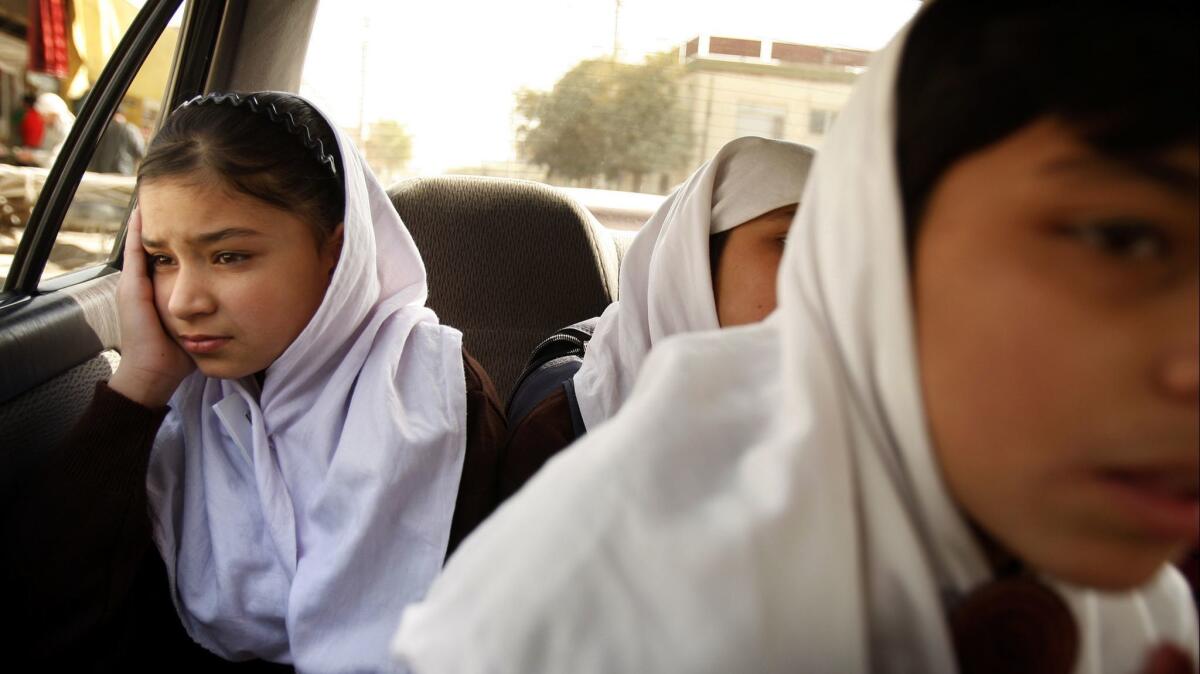Op-Ed: Nearly one in five girls is wed before she turns 18. Think about them on Valentine’s Day

Every year the world celebrates love, romance and marriage on Valentine’s Day.
But there’s one kind of marriage that shouldn’t be celebrated. Today, about one in five girls is wed before she turns 18. For Valentine’s Day, the United Nation’s Population Fund promotes using the hashtag #IDONT, as part of its campaign to end child marriage.
For me, the mission is personal.
At an age girls should be starting middle school, my grandmother was instead getting married. At 11, she had her first baby, eventually having nine children who survived to adulthood. Though it was never explicitly forbidden as a topic of conversation, her lost childhood was not discussed in my family. It was dismissed as simply how things were done in India back then.
In Kenya, where I currently serve, nearly one in four girls marries before her 18th birthday, often because they are forced by their families to do so.
While we’ve seen progress in some areas of gender equality, child marriage — one of the most egregious human rights violations against women and girls — remains widespread. Even today, India has the highest number of child brides in the world. And in some places, such as Yemen, the number of child marriages continues to rise as a result of conflict or famine.
The problem is by no means confined to active war zones or developing countries, however.
A recent investigation by the Associated Press found that the U.S. had approved thousands of requests by men to bring in child and adolescent brides to live in the United States over the past decade. In 2013, for example, a petition was approved from a 71-year-old man for his 17-year-old Guatemalan wife.
Alarmingly, such approvals do not violate U.S. laws. As the AP article noted, U.S. Citizenship and Immigration Services bases its decisions on whether child marriages are legal in the home country and in the state where the petitioner lives. Last year, two U.S. states, Delaware and New Jersey, took the important step of banning child marriage. But most states still have laws allowing marriage for underage girls in certain circumstances.
In Kenya, where I currently serve, nearly one in four girls marries before her 18th birthday, often because they are forced by their families to do so. This practice is especially common among the country’s refugee population. Kenya hosts the world’s oldest and largest refugee camps, where thousands of families escaping conflict in South Sudan, Somalia and the Democratic Republic of Congo have settled. Displaced girls are particularly vulnerable to being married off by their families.
Child marriage is often a troubling precursor to a lifetime of violence and thwarted potential. Girls who marry young are typically forced to quit school and risk serious health complications from early and multiple pregnancies. They often are subjected to physical and psychological abuse.
The range of actions — and inaction — that fall within the scope of gender-based violence include the obvious ones, like domestic abuse and sexual assault, as well as less obvious ones, like the denial of reproductive health services and education. Child brides are unlikely to participate in the economy in a meaningful way, remaining trapped in a cycle of poverty that can persist across generations.
On the other hand, enabling girls to remain in school, marry as adults and have children that are planned would allow them to realize their full potential, something that could generate billions of dollars in wealth and productivity worldwide. A 2016 Africa Human Development Report from the United Nations Development Program found that gender inequality costs sub-Saharan Africa $95 billion per year on average.
While the roots of gender-based violence and discrimination are complex and often deeply ingrained, solutions exist. They just need greater support. Empowering women and girls is often as basic as providing access to education, job training and adequate food.
Enter the Fray: First takes on the news of the minute »
Eliminating child marriage will require addressing two major challenges: Changing long-held cultural norms and alleviating poverty so that families have no incentive to marry off their daughters, whether for dowries or to reduce the number of mouths to feed.
We are making some progress. In Kenya, First Lady Margaret Kenyatta’s push to reduce maternal and infant deaths has been aimed at the most vulnerable, especially child brides. The government of Kenya and the U.N. are also investing in grassroots advocacy to spread awareness about the dangers of child marriage. This has meant cultivating voices, including young men, who can effectively denounce such harmful traditions to other community members. This is known as the #HeForShe initiative launched by the United Nations.
I can only imagine how my grandmother’s life might have been different if she had been able to learn how to read and write, to play with her friends instead of taking care of babies, to simply be a child. She was denied these basic human rights.
In her memory, I’m standing up for the millions of girls who deserve to decide if, who and when they will marry.
Siddharth Chatterjee is the United Nations resident coordinator to Kenya.
More to Read
A cure for the common opinion
Get thought-provoking perspectives with our weekly newsletter.
You may occasionally receive promotional content from the Los Angeles Times.










